Gubbins D., Herrero-Bervera E. Encyclopedia of Geomagnetism and Paleomagnetism
Подождите немного. Документ загружается.

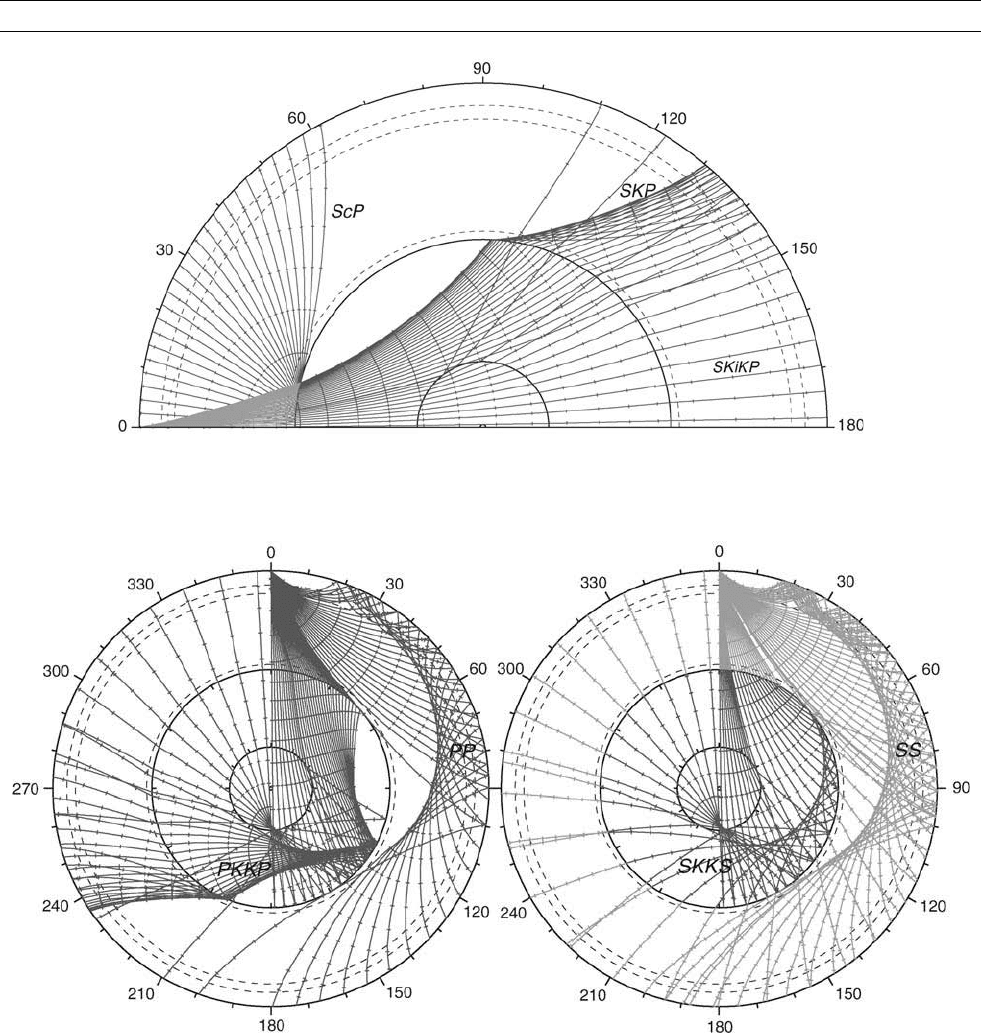
of the BC branch tend to extend beyond the ray theoretical predictions.
For epicentral distances beyond the C point, there is the possibility of
diffraction around the inner core. At the B caustic the real branch does
not just stop and there will be frequency dependent decay into the sha-
dow side of the caustic. In addition scattering in the mantle from PKP
produces short-period arrivals as precursors to PKIKP that can be seen
because they arrive in a quiet portion of the seismic record. The envel-
ope of possible precursors is indicated in Figure S24.
The pattern of branches for the SKS phase is somewhat different
because the P wavespeed at the top of the core is higher than the S
at the base of the mantle.
The AC branch extends from S incident on the core-mantle bound-
ary that can just propagate as P at the top of the outer core and emerge
at A 63
, through to grazing incidence at the inner core boundary at
C. Diffracted waves around the inner core can extend the branch
beyond the formal C point. The DF branch (SKIKS) again corresponds
to refracted waves in the inner core. The postcritical reflections from
the inner core boundary (SKiKS) form the CD branch and connect
directly into the precritical reflection at shorter distances than the D
point at 104
(Figure S25).
When the refraction just begins at A, the S wave path to the same
epicentral distance is shorter and SKS is about 75 s behind S. However,
as the proportion of faster P wave path in the core increases, the dis-
crepancies in S and SKS travel time are reduced. Eventually, the travel
time of SKS becomes less than that for S at the same epicentral
distance. Beyond 83
SKS becomes the onset of the shear wave group
Figure S22 Ray paths for the converted phases ScP and SKiKP.
Figure S23 Ray paths for multiply reflected phases (a) PP, PKKP, (b) SS, SKKS.
906 SEISMIC PHASES
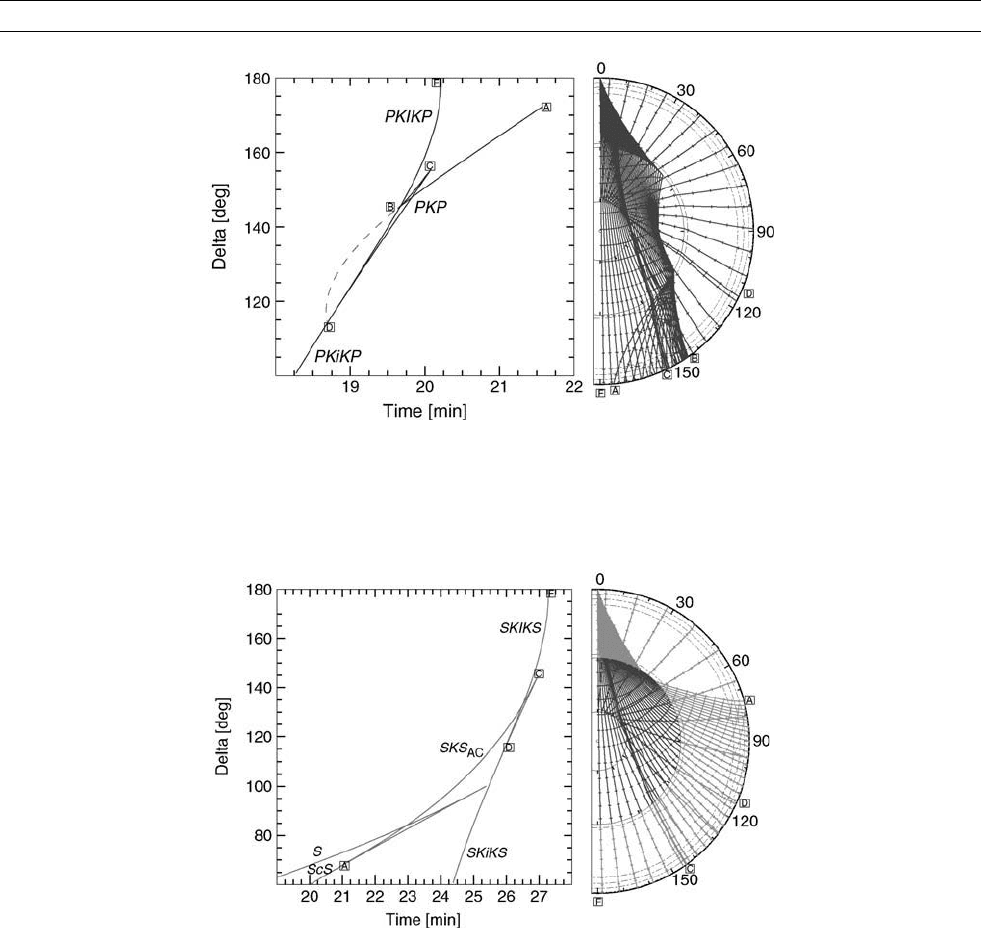
and vertically polarized S, Sdiff have to be sought in the SKS coda. The
transversely polarized S wave is very distinct and small precursory
SKS contributions (as in Figure S18) can arise from either anisotropy
of heterogeneity in passage through the mantle.
Brian Kennett
Bibliography
Duess, A., Woodhouse, J.H., Paulssen, H., and Trampert, J., 2000. The
observation of inner core shear phases. Geophysical Journal Inter-
national, 142:67–73.
Kennett, B.L.N., 2002. The Seismic Wavefield II: Interpretation
of seismograms on regional and global scales. Cambridge:
Cambridge University Press.
Kennett, B.L.N., Engdahl, E.R., and Buland, R., 1995. Constraints on
seismic velocities in the Earth from travel times. Geophysical
Journal International, 122: 108–124.
Shearer, P.M., 1999. An Introduction to Seismology. Cambridge:
Cambridge University Press.
Stein, S., and Wysession, M., 2003. An Introduction to Seismology,
Earthquakes, and Earth Structure. Oxford: Blackwell Publishing.
Cross-references
Earth Structure, Major Divisions
Inner Core, PKJKP
Inner Core Seismic Velocities
Lehmann, Inge (1888–1993)
Oldham, Richard Dixon (1858–1936)
Figure S24 Rays and travel times for PKP for the AK135 model, wavefronts are indicated by tick marks at 60 s intervals. The critical
points for the various PKP branches are indicated on both the travel time curve and the ray pattern. The dashed segment indicates the
locus of precursors to PKIKP from scattering at the core-mantle boundary.
Figure S25 Rays and travel times for SKS for the AK 135 model. S legs are plotted in grey and wavefronts are indicated by tick marks at
60 s intervals. The critical points for the various SKS branches are indicated on both the travel time curves and the ray pattern.
SEISMIC PHASES 907

SEISMO-ELECTROMAGNETIC EFFECTS
Seismo-electromagnetic effects refer to electromagnetic (EM) signals
generated by fault failure processes in the Earth’s crust. These may
occur slowly (when associated with plate tectonic loading, slow earth-
quakes, postseismic slip, etc.) or rapidly preceding, during and follow-
ing earthquakes. Several different physical processes related to crustal
failure can contribute to the generation of seismo-electromagnetic
(SEM) effects. Unambiguous observations of SEM effects provide
new independent information about the physics of fault failure. Causal
relations between co-seismic magnetic field changes and earthquake
stress drops have been clearly documented. However, despite several
decades of high quality monitoring, clear demonstration of the
existence of precursory EM signals has not been achieved.
Brief history
Suggestions that electromagnetic field disturbances are a consequence
of crustal failure processes have been made throughout recorded
history. Unfortunately, much of the earliest work was recognized
as spurious by Reid (1914) who showed that transients recorded by
magnetographs located close to earthquake epicenters resulted from
earthquake shaking, not earthquake source processes. This invalidated
earlier reports from magnetic variometers (suspended magnets) and
other instruments sensitive to ground displacement, acceleration, and
rotation common in epicentral regions during the propagation of
seismic waves. Other early problems resulted from inadequate rejec-
tion of ionospheric, magnetospheric, and man-made noise (Rikitake
et al., 1966).
Since the mid-1960s, these problems have been avoided through the
use of absolute magnetometers installed in regions of low magnetic
field gradient to reduce sensitivity to earthquake shaking and by the
application of new noise reduction techniques. As a consequence,
unambiguous observations of EM variations related to earthquakes
and tectonic stress/strain loading, have now been obtained near active
faults in many countries (Japan, China, Russia, USA, and other loca-
tions). However, careful work still needs to be done to convincingly
demonstrate causality between “precursory” EM signals and earth-
quakes and consistency with other geophysical data reflecting the state
of stress, strain, material properties, fluid content, and approach to
failure of the Earth’s crust in seismically active regions.
Physical mechanisms involved
The loading and rupture of water-saturated crustal rocks during earth-
quakes, together with fluid/gas movement, stress redistribution, change
in material properties, has long been expected to generate associated
magnetic and electric field perturbations. The primary mechanisms
for generation of electric and magnetic fields with crustal deformation
and earthquake related fault failure include piezomagnetism, stress/
conductivity, electrokinetic effects, charge generation processes,
charge dispersion, magnetohydrodynamic effects, and thermal remag-
netization and demagnetization effects. Physical limitations, con-
straints, and frequency limitations placed on these processes are
discussed in Johnston (2002).
Basic measu rement limitations
The precision of local magnetic and electric field measurements on
active faults varies as a function of frequency, spatial scale, instrument
type, and site location. Most measurement systems on the Earth’s sur-
face are limited more by noise generated by ionosphere, magneto-
sphere, and cultural noise than by instrumental noise. Thus, systems
for quantifying these noise sources are of crucial importance if changes
in electromagnetic fields are to be uniquely identified. For spatial scales
of a few kilometers to a few tens of kilometers comparable to moderate
magnitude earthquake sources, geomagnetic, and electric noise power
decreases with frequency as 1/f
2
, similar to the “red” spectrum behavior
of most geophysical parameters. Against this background noise, transi-
ent magnetic fields can be measured to several nanotesla over months, to
1 nT over days, to 0.1 nT over minutes, and 0.01 nT over seconds. Long
term changes and field offsets can be determined if their amplitudes
exceed about a nanotesla. Comparable electric field noise limits are
10 mV km
1
over months, several mV km
1
over days, 1 mV km
1
over minutes and 0.1 mV km
1
over seconds. EM noise increases
approximately linearly with site separation. Cultural noise further com-
plicates measurement capability because of its inherent unpredictability.
This largely precludes measurements in urban areas. At lower frequen-
cies (microhertz to hertz) for both electric and magnetic field measure-
ments, the most common technique involves the use of reference sites
with synchronized data sampling in arrays using site spacing compar-
able to the expected source sizes of a few tens of kilometers. Adaptive
filtering, use of multiple variable-length sensors in the same and nearby
locations further reduce noise by about a factor of 3.
These same techniques can be applied to electromagnetic field
measurements at higher frequencies (100 Hz to MHz) but much less
is known about the scale and temporal variation of noise. These fre-
quencies may be less important since basic physics precludes simple
propagation of high-frequency EM signals from seismogenic depths
(5–100 km) on active faults in the Earth’s crust where the electrical
conductivity is more than 0.1 S m
1
.
Recent results: general constraints
If reliable magnetic and electric field observations are indeed source
related, clear signals should occur at the time of large local earth-
quakes because the primary energy release occurs at this time. These
signals should scale with the earthquake moment (size) and source
geometry. In fact, co-event observations provide a determination of
stress sensitivity since the stress redistribution and the source geometry
of earthquakes are well determined. With this “calibration,” SEM
effects can be quantified and spurious signals identified. Observations
without consistent and physically sensible co-seismic effects are
generally considered suspect.
High-resolution strain data at the epicenters of moderate to large
earthquakes show that precursive moment release during the months
to minutes before rupture is less than 0.1% of that occurring coseismi-
cally (Johnston and Linde, 2002). This strongly limits the scale of
precursive failure and the expected “size” of precursive effects.
Examples of seismomagnetic effects
The primary features of seismomagnetic effects are shown in Figure S26
from Mueller and Johnston (1998). It is apparent that maximum signals
are not more than a nanotesla or so and these signals occur only for
larger earthquakes (M > 6) for which corresponding strain changes
are about a microstrain or so. An example of a magnetic record
observed at the epicenter of the 1986 M5.9 North Palm Springs earth-
quake and 17 km from the 1992 M7.4 Landers earthquake is shown in
Figure S27. For this, and some 40 other earthquakes with magnitude
between 5.5 and 7.4, no significant precursory magnetic signals were
observed.
Seismoelectric effects
Seismoelectric observations that show expected scaling with both
earthquake moment release and inverse distance cubed are difficult
to make because of the sensitivity of electrode contact potential to
earthquake shaking. Measurements of electrical resistivity to better
than 1% have been made since 1988 in a well designed experiment
installed near Parkfield, California (Park, 1997). An expected M6
earthquake together with several M5 earthquakes have occurred
beneath this array since 1990. None of these earthquakes generated
908 SEISMO-ELECTROMAGNETIC EFFECTS
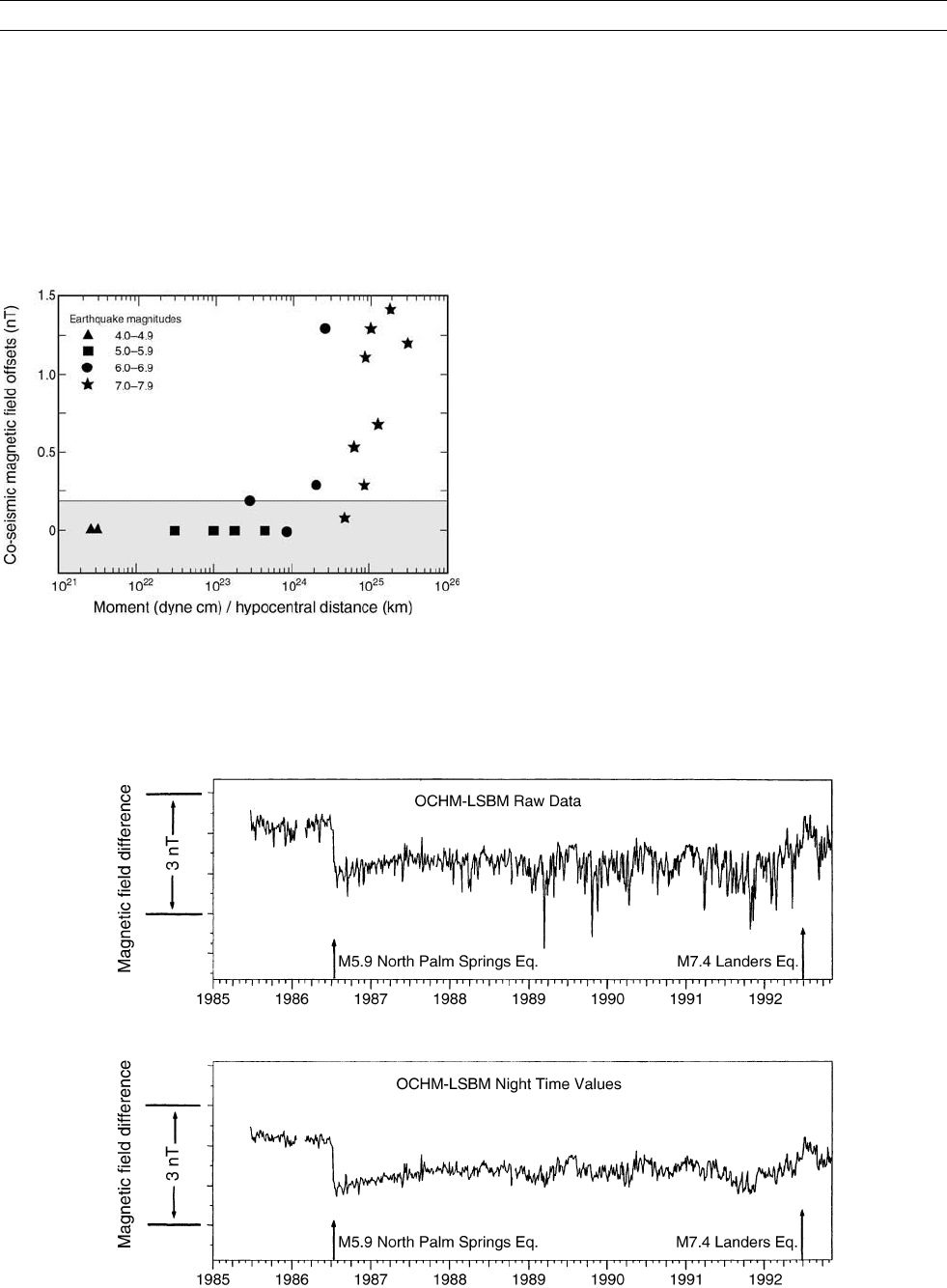
any observable changes in resistivity above the measurement resolu-
tion (Park, 1997; Langbein et al., 2005).
Indirect observations of possible SE signals might be obtained using
the magnetotelluric (MT) technique to monitor apparent resistivity in
seismically active regions. Even with the best designed systems using
remote referencing systems to reduce noise and obtain stable impe-
dance tensors, it is difficult to reduce errors below 5% for good sound-
ings and 10–40% for poor soundings.
Possible high-frequency precurs ory effects
A number of observations purported to be high-frequency SEM effects
have been recently reported (Hayakawa, 1999). Interest in these higher
ULF frequencies primarily resulted from the fortuitous observation of
elevated ULF noise power on a single 3-component magnetometer
near the epicenter of the M7.1 Loma Prieta earthquake of October 18,
1989. However, similar records were not obtained with the 1992
M7.4 Landers earthquake, the 1994 M6.7 Northridge earthquake, the
1999 M7.1 Hector Mine earthquake, the 1999 M7.4 Izhmet, Turkey
earthquake and the 2004 M6 Parkfield, Ca, earthquake.
Though controversial, increased interest in tectonoelectric (TE) phe-
nomena related to earthquakes has resulted from suggestions in Greece
and Japan that short-term geoelectric field transients (SES) of particu-
lar form and character precede earthquakes with M > 5 at distances up
to several hundreds of kilometers. These transients appear to have a
spatially uniform source field on the scale of the array but no clear cor-
responding magnetic field transients and no sensible coseismic effects.
The SES have been empirically associated with subsequent distant
earthquakes and claimed as precursors (Varotsos et al., 1996).
Careful study of the SES recordings indicates that the SES signals
have the form expected from rectification/saturation effects of local
radio transmissions from high-power transmitters on nearby military
bases. Without any clear physical explanations describing how the
SES signals are earthquake generated yet coseismic effects related to
the much larger earthquake source are not observed, these observations
have been extremely controversial (Debate on VAN, 1996).
Another enigma concerns the generation of high-frequency (>1 kHz)
electromagnetic emissions associated with subsequent moderate earth-
quakes but, again, with no coseismic effects. Such emissions are
reported to have been detected at great distances from these earthquakes
(see summary by Hayakawa and Fujinawa, 1994) and by magnet-
ometers onboard satellites. However, the statistical significance of these
observations is under dispute.
The generation of high-frequency electromagnetic radiation can be
easily demonstrated in controlled laboratory experiments involving
Figure S26 Co-seismic magnetic field offsets as a function of
seismic moment scaled by hypocentral distance. The shaded
region shows the 2-sigma measurement resolution (from Mueller
and Johnston, 1998). Geodetically based seismomagnetic models
(Sasai, 1991) fit each offset.
Figure S27 Magnetic field differences between stations OCHM and LSBM before, during and after the July, 1986 M5.9 North Palm
Springs and the June, 1992 M7.4 Landers earthquakes (from Johnston et al., 1994).
SEISMO-ELECTROMAGNETIC EFFECTS 909

rock fracture in dry rocks. However, the Earth’s crust in seismically
active areas is quite conducting (0.3–0.001 S m
1
) and propagation
of very high-frequency (VHF) electromagnetic waves even short dis-
tances through the crust is difficult to justify physically. Propagation
from earthquake source regions (10–100 km in depth), and in some
cases through oceans with conductivities of 1 S m
1
, is physically
implausible. More significantly, the amount of allowable rock fractur-
ing prior to earthquakes is strongly constrained by high sensitivity
crustal strain measurements in the near-field of many earthquakes.
These measurements indicate moment release (m slip area) prior
to earthquakes is at least three orders of magnitude smaller than that
released at the time of an earthquake (Johnston and Linde, 2002).
Appeal to secondary sources at the Earth’s surface may avoid this
difficulty but the expected associated near-field crustal strain and
displacement fields are not observed.
High-frequency disturbances are generated in the ionosphere as a
result of coupled infrasonic waves generated by earthquakes and are
readily detected with routine ionospheric monitoring techniques and
global position system (GPS) measurements. In essence, displacement
of the Earth’s surface by an earthquake acts like a huge piston, gener-
ating propagating pressure waves in the atmosphere/ionosphere wave-
guide. Thus, traveling waves in the ionosphere (traveling ionospheric
disturbances or TIDs) are a consequence of earthquakes (and volcanic
eruptions). EM data at VHF frequencies recorded on ground receivers
or by satellite require correction for TID and other disturbances before
any association can be made to source processes or earthquake
precursors.
Malcolm J.S. Johnston
Bibliography
Debate on VAN, 1996. Special issue. Geophysical Research Letters,
23: 1291–1452.
Hayakawa, M. (ed.), 1999. Atmospheric and Ionospheric Electromag-
netic Phenomena Associated with Earthquakes. Tokyo: Terra
Scientific Publishing Company, p. 996.
Hayakawa, M., and Fujinawa, F. (eds.), 1994. Electromagnetic Phe-
nomena Related to Earthquake Prediction. Tokyo: Terra Scientific
Publishing Company, p. 677.
Johnston, M.J.S., 2002. Electromagnetic fields generated by earth-
quakes. International Handbook of Earthquake and Engineering
Seismology, Volume 81A. New York: Academic Press, pp. 621–635.
Johnston, M.J.S., and Linde, A.T., 2002. Implications of crustal strain
during conventional, slow and silent earthquakes. International
Handbook of Earthquake and Engineering Seismology, Volume
81A. New York: Academic Press, pp. 589– 605.
Johnston, M.J.S., Mueller, R.J., and Sasai, Y., 1994. Magnetic field
observations in the near-field of the 28 June 1992 M7.3 Landers,
California, earthquake. Bulletin of the Seismological Society of
America, 84: 792–798.
Langbein, J., Borcherdt, R., Dreger, D., Fletcher, J., Hardebeck, J.L.,
Hellweg, M., Ji, C., Johnston, M., Murray, J.R., Nadeau, R.,
Rymer, M., and Treiman, J., 2005. Preliminary report on the 28
September 2004, M 6.0 Parkfield, California earthquake. Seismolo-
gical Research Letters, 76:10–26.
Mueller, R.J., and Johnston, M.J.S., 1998. Review of magnetic field
monitoring near active faults and volcanic calderas in California:
1974–1995. Physics of the Earth and Planetary Interiors, 105 :
131–144.
Park, S.K., 1997. Monitoring resistivity change in Parkfield,
California: 1988–1995, Journal of Geophysical Research, 102:
24545–24559.
Reid, H.F., 1914. Free and forced vibrations of a suspended magnet.
Terrestrial Magnetism, 19:57–189.
Rikitake, T., 1966. Elimination of non-local changes from total inten-
sity values of the geomagnetic field. Bulletin of Earthquake
Research Institute, 44: 1041–1070.
Sasai, Y., 1991. Tectonomagnetic modeling on the basis of linear
piezomagnetic effect. Bulletin of the Earthquake Research Insti-
tute, 66: 585–722.
Varotsos, P., Eftaxias, K., Lazaridou, M., Nomicos, K., Sarlis, N.,
Bogris, N., Makris, J., Antonopoulos, G., and Kopanas, J., 1996.
Recent earthquake predictions results in Greece based on the obser-
vation of seismic electric signals. Acta Geophysica Polonica, 44:
301–307.
Cross-references
Geomagnetic Spectrum, Temporal
Gravity-Inertio Waves and Inertial Oscillations
Magnetotellurics
Volcano-Electromagnetic Effects
SHAW AND MICROWAVE METHODS,
ABSOLUTE PALEOINTENSITY DETERMINATION
The Shaw technique is used to determine the strength of the Earth ’s
magnetic field from igneous rocks and man fired artifacts. In this tech-
nique (Shaw, 1974) the natural remanent magnetization (NRM) of the
sample is demagnetized using alternating field (AF) demagnetization
but is remagnetized by heating to above the Curie temperature and
cooling in a known field to form a full thermoremanent magnetization
(TRM) in a known field strength. By comparing the NRM and TRM
values it is possible to calculate the strength of the field in which the
NRM was formed. There are checks for alteration of the sample and
also several variations of the original technique that are described
below.
The original Shaw technique
This technique used anhysteretic remanent magnetizations (ARMs) to
check for any alteration in the sample due to the laboratory heating.
There are four demagnetization stages to the experiment:
1. AF demagnetize the NRM in steps to a maximum AF value.
2. Give the sample an ARM in a known constant field in the maxi-
mum AF used in 1 (ARM1) and AF demagnetize in the same steps
used in 1.
3. Give the sample a full TRM in a known constant laboratory field
strength and AF demagnetize in the same steps used in 1.
4. Give the sample an ARM in the same known field as used in 2
(ARM2) and AF demagnetize in the same steps used in 1.
The basic premise is simply that if a sample can be demagnetized
between two AF values then it can also be remagnetized with an
ARM between those values. The value of the ARM is not simply
related to the value of the NRM (or TRM) lost between those AF
values but it is a function of the samples’ ability to retain magnetiza-
tion between those two AF values. If the sample becomes altered dur-
ing heating to form the TRM in such a way that the ability to retain
magnetization (TRM or ARM) between those two values changes,
then the value of ARM2 (given after heating) between the two AF
values will be different from the value of ARM1 (which was given
before heating and, therefore, before alteration).
By plotting the demagnetization values of ARM1 against ARM2
and using the value of the AF demagnetizing field as a parameter,
the slope of the line should be unity if there has been no alteration
of the sample. If there has been alteration, then the slope will not be
unity. By selecting the continuous AF demagnetization region where
the slope is unity (if such a region exists) and plotting NRM against
TRM it is possible to calculate the ratio NRM/TRM (Figure S28)
910 SHAW AND MICROWAVE METHODS, ABSOLUTE PALEOINTENSITY DETERMINATION
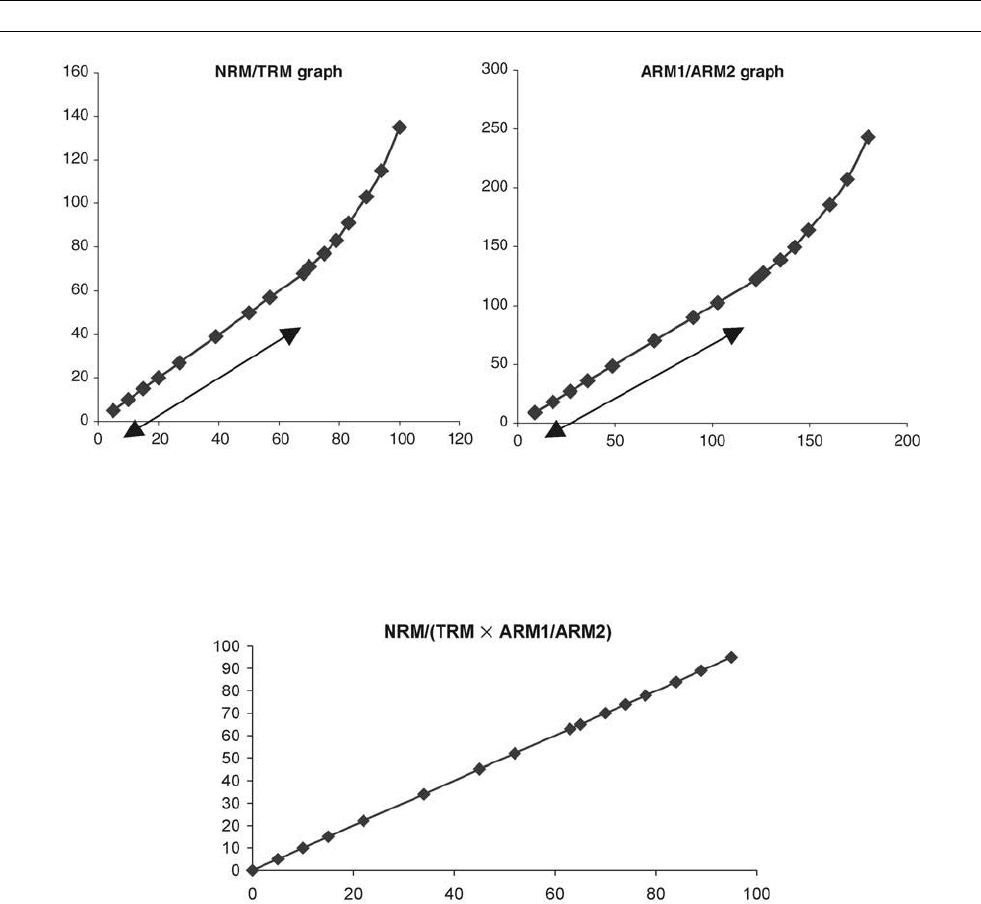
which is the same ratio as the ancient field strength/laboratory field
strength (Nagata, 1943).
Kono, and Rolph and Shaw corrections
Kono (1978) proposed that samples with altered TRMs could be
used for paleointensity analysis provided that the NRM/TRM graph
has a linear segment and that the equivalent ARM1/ARM2 graph is
also linear. He proposed multiplying the paleointensity obtained from
the NRM/TRM linear section by the inverse of the slope of the equiva-
lent ARM1/ARM2 section in order to correct for laboratory thermal
alteration.
Rolph and Shaw (1985) proposed that the degree of alteration of the
TRM was reflected in the degree of alteration of ARM2 and so it
should be possible to use the ARM data to continuously correct for
alteration in the TRM. In order to achieve this, the final highest AF
field value of NRM, TRM, ARM1, and ARM2 are subtracted from
their respective data. Each TRM value is then multiplied by the ratio
of ARM1/ARM2 for the same AF value. A new graph plotting
NRM against TRM ARM1/ARM2 should correct for any alteration
of the TRM due to laboratory heating (Figure S29).
Double heating technique
Following on from the Rolph and Shaw correction, Tsunakawa and
Shaw (1994) applied a second heating to form a second TRM
(TRM2) in the same field as the first TRM (TRM1). If both the first
and second heatings cause thermal alteration, then it is possible to
check if the ARM correction proposed by Rolph and Shaw works by
plotting TRM1 against ARM corrected TRM2. The slope of the line
should be unity if the correction works. This adaptation of the Shaw
technique is lengthier because of the need for two heatings and a third
set of ARM measurements but it gives confidence to final result if the
TRM2 correction works.
Figure S28 Shaw technique paleointensity analysis, the high AF region of the ARM1/ARM2 graph is linear with slope 1 (marked with
double ended arrow). The same AF region on the NRM/TRM graph is also linear and as this AF region is unaltered the paleointensity
value can be calculated from the slope.
Figure S29 The data in this figure analyzed using the Rolph and Shaw correction where changes in ARM are used to correct for changes
in TRM. In the Rolph and Shaw technique only data with peak AF values above 0.1 T were used in order to restrict the analysis to single
or pseudosingle domain grains.
SHAW AND MICROWAVE METHODS, ABSOLUTE PALEOINTENSITY DETERMINATION 911

Low temperat ure demagnetization double heating
technique
Tsunakawa et al. (1997) and Yamamoto et al. (2003) used low tem-
perature demagnetization (LTD) in conjunction with the double heat-
ing technique. The low temperature demagnetization (to liquid
nitrogen temperature) removed the magnetization formed during high
temperature oxidation of the magnetic grains. Although the technique
is lengthy, it has provided accurate paleointensity determinations from
recent Hawaiian lavas.
John Shaw
Bibliography
Kono, M., 1978. Reliability of palaeointensity methods using alternat-
ing field demagnetization and anhysteretic remanence. Geophysical
Journal of Royal Astronomical Society, 54: 241–261.
Nagata, T., 1943. The natural remnant magnetism of volcanic rocks
and its relation to geomagnetic phenomena. Bulletin of the Earth-
quake Research Institute, 21:1–196.
Rolph, T.C., and Shaw, J., 1985. A new method of palaeofield magni-
tude correction for thermally altered samples and its application
to Lower Carboniferous lavas. Geophysical Journal of Royal
Astronomical Society, 80: 773–781.
Shaw, J., 1974. A new method of determining the magnitude of the
palaeomagnetic field. Application to five historic lavas and five
archaeological samples. Geophysical Journal of Royal Astronomi-
cal Society, 39: 133–144.
Tsunakawa, H., and Shaw, J., 1994. The Shaw method of palaeointen-
sity determination and its application to recent volcanic rocks.
Geophysical Journal International, 118: 781–787.
Tsunakawa, H., Shimura, K., and Yamamoto, Y., 1997. Application of
Double Heating Technique of the Shaw Method to the Brunhes
Epoch Volcanic Rocks. 8th Scientific Assemble of IAGA.
Yamamoto, Y., Tsunakawa, H., and Shibuya, H., 2003. Palaeointensity
study of the Hawaiian 1960 lava: implications for possible causes
of erroneously high intensities. Geophysical Journal International,
153: 263–276.
Cross-references
Demagnetization
Magnetization, Natural Remanent (NRM)
Magnetization, Thermoremanent (TRM)
SHOCK WAVE EXPERIMENTS
Introduction and background
Shock wave experiments have a special place in the study of the
Earth’s interior and the interiors of the terrestrial planets because vir-
tually the entire pressure (to 470 GPa) and temperature (to 6000 K)
ranges existing with these objects can be achieved, via this technique,
in the laboratory. The study of the properties of iron and alloys, solid
and molten, relevant to core composition via shock compression to
high pressures and temperatures of the Earth and planetary cores has
continued to challenge mineral physicists.
The geomagnetic field is thought to be generated by complex con-
vective flows of electrically conducting Fe-rich fluids in the fluid outer
core. The author has measured physical properties under shock com-
pression which provide information on where possible Fe-rich materi-
als are fluid and, hence, where convection and generation of the
geomagnetic field occurs.
Dynamic compression of cosmochemically candidate metal-like
compounds which, in the molten state, are soluble in molten iron such
as FeS, FeO, FeC, FeSi, and FeH
2
continue to be of interest to theories
of the formation and evolution of the molten conductive cores that
generates the Earth’s and other planetary magnetic fields (see Core
composition). The electrical resistivity of iron alloys and compounds
under shock compression are compared to approximate bounds for
the Earth that are derived theoretically. Recent compositional and ther-
modynamic models of the Earth’s core (see Core, adiabatic gradient)
have been strongly revised (Anderson and Ahrens, 1994; Poirier,
1994; Stacey, 2001; Anderson and Isaak, 2002) in part, on account
of new shock wave data for iron and its alloys.
Here we present a summary of modern techniques for shock wave
equation of state (EOS) (pressure-volume-energy) measurements
which are applicable to condensed matter, in general, and specific to
iron and its alloys. The study of compression behavior of other stan-
dard materials and phase transitions in selected materials have pro-
vided standards for the more widely used diamond and multianvil
high pressure apparatuses (Holzapfel, 1996). Improvements in techni-
ques for measuring sound, or rarefaction velocity in shock-compressed
material (Brown and McQueen, 1986; McQueen, 1992; Chen and
Ahrens, 1998) have continued to complement the EOS measurements
for these materials and provide data specifying whether materials in
various shock states are in solid, partially or completely molten form.
Such data also provide firm constraints on the high-pressure and
high-temperature Grüneisen parameter of iron and iron alloys (see
Grüneisen’s parameter for iron and Earth’s core). As discussed
below, knowledge of the Grüneisen ratio of iron is crucial to reducing
shock wave data to pressure-volume isotherms and isentropes so that
it may be compared to data from other sources, as well as to constrain
the thermodynamic models of the Earth’s core.
Shock wave generation and the Rankine-Hugoniot
equation
The shock waves used for dynamic compression research must be
maintained for time intervals of 10
3
times the intrinsic rise-time t
s
of the shock front (Figure S30).
The impact of gun and explosively launched flyer plates both pro-
vide the requisite nearly steady waves in materials. For steady waves,
a shock, with velocity U with respect to the laboratory, independent of
time, can be defined and conservation of mass, momentum, and energy
across a shock front can be expressed as:
r
1
¼ r
0
U=ðU u
1
Þ; (Eq. 1)
P
1
¼ r
0
u
1
U; (Eq. 2)
E
1
E
0
¼ P
1
ð1=r
0
1=r
1
Þ=2 ¼ 1=2u
2
1
; (Eq. 3)
where r, u, P, and E are density, particle velocity, shock pressure, and
internal energy and, (as indicated in Figure S31), the subscripts 0 and 1
refer to the state in front of and behind the shock front, respectively. It
should be understood that in this section, pressure is used in place of
stress in the indicated wave propagation direction. Actually stress, in
the wave propagation direction, is what is specified by (2). A detailed
derivation of (1) –(3) is given in Melosh (1989). Equation (3) also indi-
cates that the material achieves an increase in internal energy (per
unit mass) which is exactly equal to one-half of the kinetic energy
per unit mass.
Upon driving a shock of pressure P
1
into a material, a final shock
state is achieved which is described by (1)– (3). This shock state is
shown in relation to other thermodynamic paths in Figure S32 in the
pressure-volume plane. Here V
0
¼ 1/r
0
and V ¼ 1/r. In the case of
the isotherm and isentrope, it is possible to follow, as a thermodynamic
path, the actual isothermal or isentropic curve to achieve a state on the
isotherm or isentrope. A shock or Hugoniot state is different, however.
912 SHOCK WAVE EXPERIMENTS

The Hugoniot state P
1
, V
1
is achieved via a thermodynamic path given
by the straight line called Rayleigh line (Figure S32). Thus successive
states along the Hugoniot curve cannot be achieved, one from another,
by a shock process. The Hugoniot curve itself then just represents the
locus of final shock states.
To achieve such shock waves with flat-topped stress pulses, flat
plates called flyer plates are launched with guns (Figure S33) or explo-
sive devices (Figures S34 and S35). The flyer plate impacts the sample
or a “driver plate” upon which the sample is mounted and drives a
shock into the driver plate and the sample. Although the various plate
launching systems depicted in Figures S33–S35 operate over an enor-
mous velocity range, all actual systems have shortcomings. Correc-
tions for converging flow must be made in the case of explosive
imploding systems of Figure S35. Tilt and flyer plate distortion, must
be taken into account in the case of all explosive and gun launched
impactors, as for example, indicated in Figure S36.
Comparison of electrical resistivity of shocked iron,
iron alloys, and compounds to Earth
Our understanding of the conditions required to generate the Earth’s
magnetic field provides some constraints on the electrical conductivity
of the Earth which may be usefully compared to the conductivity of
Figure S30 Generation of shock waves by flyer plate impact.
Impact induces steady flat-topped shock wave and this is followed
by a rarefaction wave (from Ahrens (1987)).
Figure S31 Profile of a steady shock wave, rise time t
s
, imparting
a particle velocity u
1
, pressure P
1
, density r
1
, and internal energy
density E
1
, propagating with velocity U into material that is
at rest at density r
0
and internal energy density E
0
(from
Ahrens (1987)).
Figure S32 Pressure-volume compression curves. For isentrope
and isotherm, the thermodynamic path coincides with the locus
of states, whereas for the shock, the thermodynamic path is a
straight line (from point 0, V
0
) to point (P
1
, V
1
) on the Hugoniot
curve (from Ahrens (1987)).
Figure S33 Diagrams of propellant gun launching system to
impact metallic targets up to 2.6 km s
1
. The iron target is
preheated with radiofrequency induction coils. Resulting target
temperature is monitored using the optical signal reflected from
gold mirror (M). Abbreviations: W: window; L: lens; M: mirror;
M (Au): gold mirror; T: EOS turning mirror. About 1 s before
launching projectile, EOS turning mirror is inserted in front of the
target free-surface (after Chen and Ahrens (1998)).
SHOCK WAVE EXPERIMENTS 913
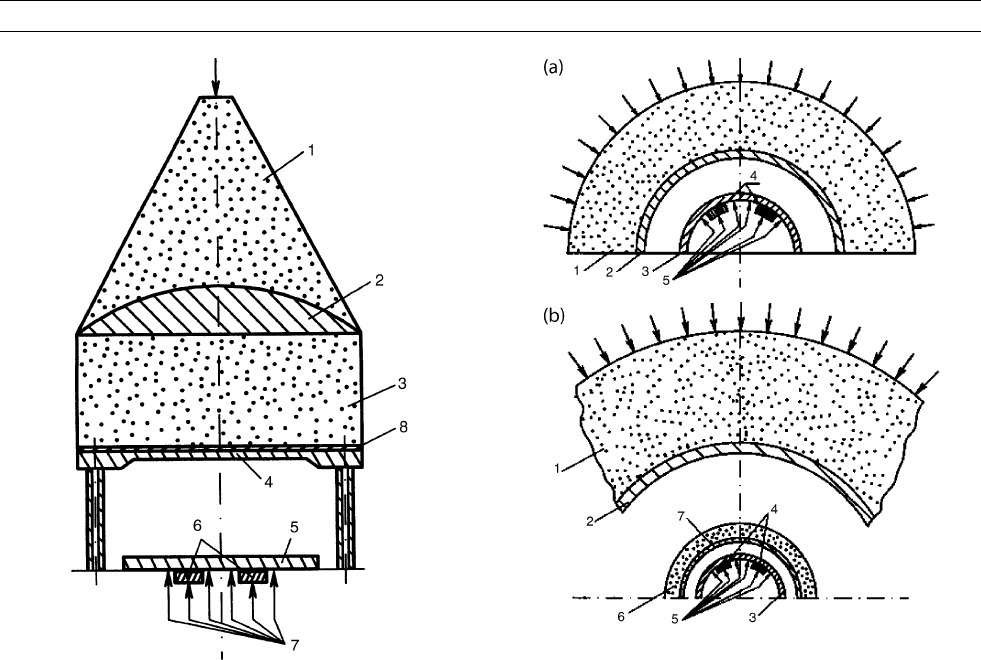
solid and molten iron and alloys as a function of temperature
and pressure.
The resistivity of the Earth’s core is thus constrained to be suffi-
ciently low, such that magnetic field lines and unable to diffuse out
of the core on the timescale of 10
4
years approximately obtained
by assuming radius of the core (usually assumed to be the inner core)
(1200 km), divided by the westward drift velocity (of features of the
magnetic field such as mapped by Bloxham and Gubbins (1985) from
the years 1715 to present). Using this loose constraint, Matassov
(1977) first showed that the core should have a resistivity of
r < 10
5
10
4
O m: (Eq. 4)
These low resistivity values assume that the magnetic field will not
diffuse out of the core over the 10
4
year time scale field deflation.
By assuming a fixed value of 8–12% of the total Earth heat flow
(44 TW) across core-mantle boundary, a lower limit resistivity of
the core region of
r < 10
6
O m (Eq. 5)
is obtained. This rather simple constraint limit is obtained by taking
the extreme assumption that the heat flow across the CMB is totally
resulting from ohmic heating by the core of the geodynamo.
As can be seen in Figure S37, upon extrapolation, the mostly
lower pressure shock data for iron, and its alloys and compounds
to 135–450 GPa, the resistivity of these media lies in the
10
–6
–10
–5
Ωm range in agreement with the very loose theoretical
expectations described above.
At least three sources of energy for powering the geodynamo are
recognized:
1. Hydrodynamic flow of core fluid induced by the difference in
dynamic ellipticity of the whole Earth versus that of the core.
2. Thermal convection of core fluid driving the geomagnetic dynamo
also appears possible. Such thermal convection could be driven by
radioactivity of the core, such as for example, supplied by
40
Kin
the core.
3. Another source of sufficient thermal energy to operate the geody-
namic dynamo is the latent heat of crystallization of the inner, solid
core.
Shock wave equation of state (EOS) measurements
In the simplest case when a single shock state is achieved via a shock
front, the Rankine-Hugoniot equations involved six variables (U, u
1
,
r
0
, r
1
, E
1
–E
0
, and P
1
); thus, measuring three, usually U, u
1
, and r
0
,
determines the shock state, r
1
, E
1
–E
0
, and P
1
.
Figure S34 Explosive flyer plate launching (to 5kms
1
)
apparatus. (1) and (2) Explosive plane-wave lens is point detonated
at upper (downwards pointing) arrow. (1) Fast detonating explosive,
(2) slow detonating explosive, (3) main explosive. (8) Plexiglas buffer
plate, (4) metal flyer plate, (5) driver plate, (6) specimens under
study, (7) electrical contactor pin switches that detect shock wave
arrival (after Al’tshuler et al. (1999)).
Figure S35 Hemispheric implosive flyer plate launching
devices for ultra-high pressure shock wave research. (a) Single
stage apparatus launches metal flyer plates to velocities of
9–11 km s
1
. (b) Explosive charge is multiply point detonated
at outer surface of explosive hemisphere. (1) Main charge,
(2) hemispherical primary flyer plate. Upon acceleration of
primary flyer plate to 5–7 km s
1
impact onto (6) secondary
explosive charge induces an overdriven detonation wave.
Overdriven detonating wave in secondary charge accelerates
(7) secondary flyer plate to velocities of up to 14 km s
1
. Upon
impact onto (3) driver plate, shock waves with pressures in
1400–1800 GPa are driven into (4) specimens. Resulting shock
velocities are measured via (5) electric contactor pin switches
(after Al’tshuler et al. (1999)).
914 SHOCK WAVE EXPERIMENTS
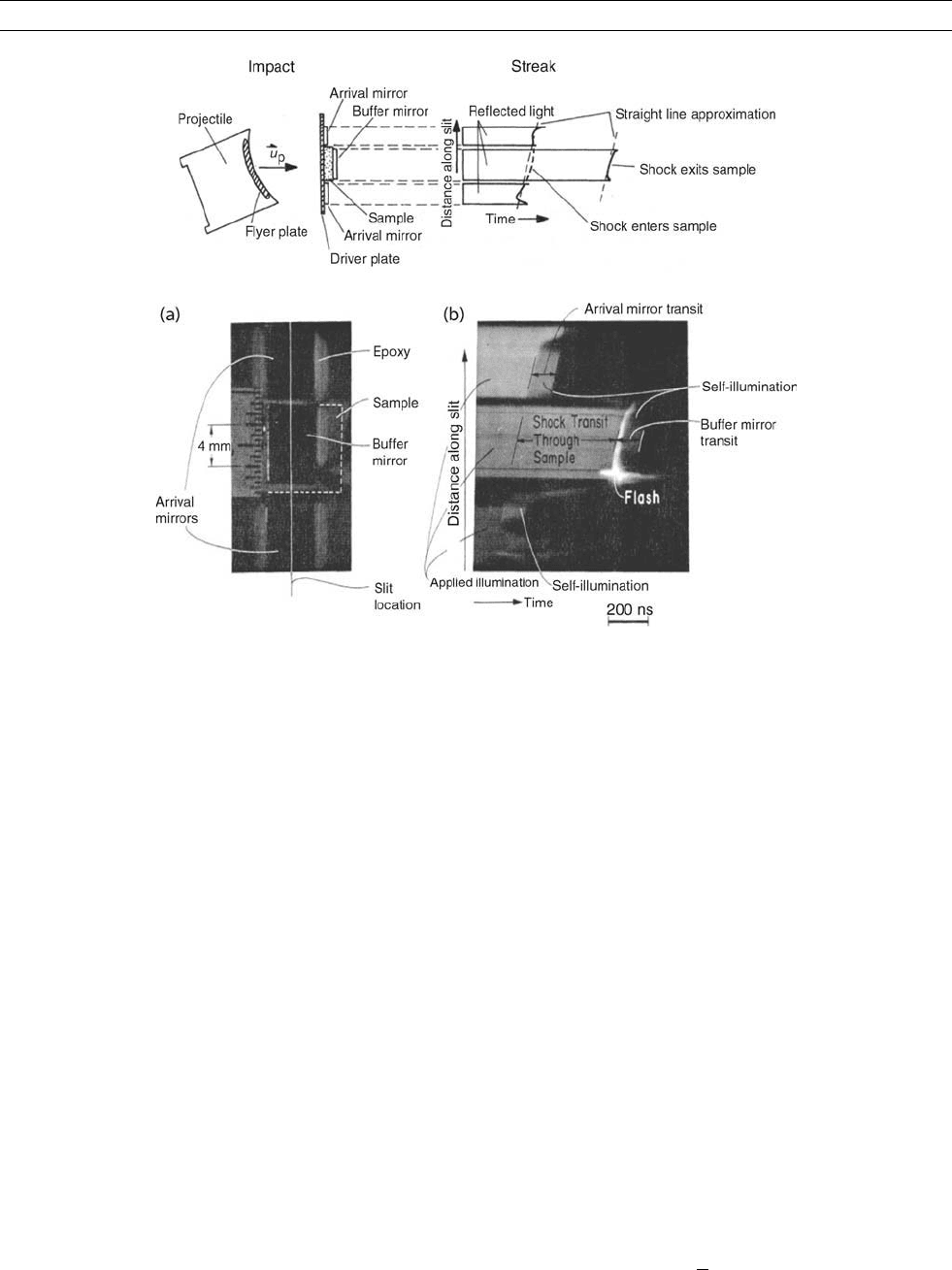
Careful measurement of sample volumes and mass can result in r
0
to be determined within 0.3%. Projectile or flyer plate velocity is
measured via successive closure of a series of contactor pin switches
or via optical or flash X-ray techniques (Ahrens, 1987). In the simplest
case where the sample and impactor are made of the same material, the
shock-induced particle velocity is
u
1
¼ u
fp
=2; (Eq. 6)
where u
fp
is the flyer plate velocity which is measured to 0.5%.
Shock velocity is usually measured to 1% via streak camera
photography (Figures S33 and S36) or via contactor pin closures
(Figures S34 and S35) as indicated.
Shock compression data for candidate core constituents are tabu-
lated by Ahrens and Johnson (1995). Upon shock compression to
greater than 13 GPa, the Hugoniot data for iron demonstrates the onset
of a 5% volume decrease upon transition from the low pressure, bcc,
a-phase to the high pressure hcp, e-phase. Moreover, the phase change
demonstrates hysteretic unloading (for example, as seen from 23 GPa
shown in Figure S38). The shock wave data for iron (up to 200 GPa
were originally obtained using explosively launched flyer plates,
Figure S34) and extended to 900, and later, 1400 GPa using the
techniques sketched in Figures S35a and b by Al’tschuler and
co-workers in the former Soviet Union (now Russia) (Ahrens and
Johnson, 1995). Shock wave data for Fe-Si (Matassov, 1977),
pyrrhotite (FeS) (Brown et al., 1984), pyrite (FeS
2
) (Ahrens and
Jeanloz, 1987), and wüstite (FeO) (Jeanloz and Ahrens, 1980) may
be used to estimate the fraction of light elements in the core by correct-
ing Hugoniot temperatures to those of the Earth (as for example as
shown in Figures S39 and S44) (see Inner Core composition and Core
temperature).
Strategy for applying shock wave data to modeling
the Earth’s core
Theoretical temperature model s of the Earth’s core
Thermal models of the outer core of the Earth have been anchored to
estimates of the pure iron melting point at 330 GPa, the pressure of the
inner core-outer core (IC-OC) boundary (see Melting temperature of
iron in the core, theory and Melting temperature of iron in the core,
experimental ). Since the temperature variation T
oc
¼ T
oc
(g/V
oc
)in
the outer core (which is assumed to be in approximately adiabatic
equilibrium) is usually modeled as an isentropic temperature distribu-
tion which is described by (see Core, adiabatic gradient):
T
oc
¼ T
icoc
exp
Z
V
oc
V
icoc
g
V
dV
: (Eq. 7)
Here g is the Grüneisen parameter of the molten material of the outer
core (usually assumed to be approximately equal to that of molten
Figure S36 (Upper) Schematic illustration (highly exaggerated) of projectile tilt and bowing, and their effect on the streak record.
Particle-velocity vector (up) is normal to target (seen edge-on) despite tilt. The arrival on the streak record corresponding to the
shock-wave entering the sample could significantly be curved due to the bowing of the projectile (after Jeanloz and Ahrens (1980)).
(Lower) (a) Experimental sample image taken through image converter camera, viewing the back-side of the target. The sample and
mirror can be seen, as well as the location of the slit. (b) Streak photograph taken by sweeping the image of the slit towards the
right (at nearly constant velocity) as the projectile impacted the target. Note the intense flash of light as the shock-wave crosses the
sample/buffer mirror interface (after Jeanloz and Ahrens (1978)).
SHOCK WAVE EXPERIMENTS 915
